Snapshots of International Community Forestry Networks: Country ...
Snapshots of International Community Forestry Networks: Country ...
Snapshots of International Community Forestry Networks: Country ...
Create successful ePaper yourself
Turn your PDF publications into a flip-book with our unique Google optimized e-Paper software.
Learning from <strong>International</strong> <strong>Community</strong> <strong>Forestry</strong> <strong>Networks</strong>: India Report<br />
on things that are absolutely relevant to our work. Some papers are good for researchers but not necessarily<br />
for people in the field.” Similarly, another <strong>of</strong>ficial remarked, “I am not a researcher, I want information that<br />
can be implemented in the field.” This view was endorsed by an NGO representative who felt that network<br />
information is mainly aimed at researchers and development workers: “FD <strong>of</strong>ficials are administrators –<br />
very few would be interested in such articles.” In a related point, it was also felt that network information is<br />
usually too sophisticated to be used directly at grassroots level. Information would be more useful if it were<br />
easier to read.<br />
In terms <strong>of</strong> specific networks, the newsletters <strong>of</strong> RDFN, FTPP and RECOFTC were generally appreciated.<br />
Three people received the FTPP newsletter, and felt that it had been useful. Useful features <strong>of</strong> the<br />
newsletter were cited as being information on workshops and seminars; information on FAO reports which<br />
the interviewee would use to acquire relevant reports; good documentation which is lacking in West<br />
Bengal; relevance in the field as well as outside the field. One person felt that the FTPP newsletter had<br />
shaped his thinking to some extent. One complaint was that contributors were mainly from the NGO or<br />
research sector, with hardly any contributions by pr<strong>of</strong>essional foresters. Significantly, though, the same<br />
person admitted that he prefers writing articles for Indian journals such as Wasteland News, because the<br />
readership within India is far better: “Not everyone has access to journals like FTPP.” It may be, therefore,<br />
that there is a vicious circle in operation in terms <strong>of</strong> the reach <strong>of</strong> network information – newsletters do not<br />
reach a wide enough range <strong>of</strong> people, which means that fewer people would take the trouble to contribute<br />
articles or information, which means that the content is not as relevant to the context as it could be, which<br />
in turn prevents the newsletter from reaching out to a wider audience. It may be useful to examine this issue<br />
in detail in the future.<br />
Two persons receive the RDFN newsletter, with varying responses. While one felt it was marginally useful,<br />
another felt that it was very relevant, not too theoretical and had been an influence on him. A complaint<br />
about RDFN was that there was not enough information on India. One person was very enthusiastic about<br />
the RDFN directory <strong>of</strong> members and RDFN thematic papers. The pr<strong>of</strong>ile <strong>of</strong> members with details <strong>of</strong> special<br />
interest in the directory was a useful tool for networking: “I have written to many people asking for<br />
information about workshops, newsletters from other countries, etc. RDFN also sends emails <strong>of</strong> new<br />
members along with the telephone number.” Another point about RDFN that was appreciated was that<br />
thematic papers were sent regularly, and sent according to the interest <strong>of</strong> the member, which is to be<br />
specified in advance. This meant that thematic papers received were always relevant and <strong>of</strong> interest.<br />
One person received the RECOFTC newsletter, and found it very useful for information on workshops,<br />
seminars and fellowships. Though he does not receive it regularly anymore, he accesses new issues on the<br />
internet. AFN publications were seen as not too useful because they presented too general a picture, and<br />
tended to focus on SE Asia.<br />
Tools <strong>of</strong> Communication / 2-way Flow <strong>of</strong> Communication:<br />
Hard copy publications were favoured as being the easiest tool <strong>of</strong> communication. Two persons felt that<br />
email excluded too many people from networks, such as lower level FD <strong>of</strong>ficials. In this context, the<br />
suggestion <strong>of</strong> one person to use CD-ROMs to circulate information, seems inappropriate. It was also felt<br />
that workshops as a method <strong>of</strong> communication, tend to reach too few people.<br />
Overall there seemed to be hardly any two-way flow between FD members and networks. None <strong>of</strong> the<br />
interviewees had ever contributed to newsletters, though one had made use <strong>of</strong> the RDFN directory to make<br />
contact with other members. One person had occasionally contributed to FTPP email discussions. Overall<br />
the relationship with networks seems to be one <strong>of</strong> receiving information.<br />
Potential:<br />
Most comments on the potential <strong>of</strong> networks focussed on improving the content <strong>of</strong> information<br />
disseminated. Some <strong>of</strong> the suggestions were as follows:<br />
• CF in India is very dependent on successful management <strong>of</strong> NTFP. <strong>Networks</strong> should put together<br />
information on NTFP management from around the world and circulate it.<br />
• <strong>Networks</strong> should circulate information about lesser-known funding agencies that can support<br />
projects.<br />
47

















![CynefinFramework final [Read-Only]](https://img.yumpu.com/19017304/1/190x135/cynefinframework-final-read-only.jpg?quality=85)